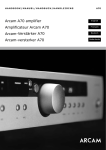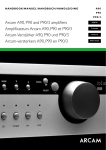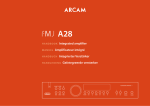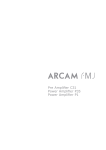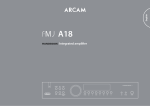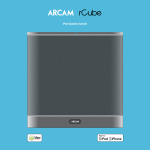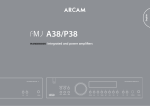Download Arcam P80 Operating instructions
Transcript
HANDBOOK/MANUEL/HANDBUCH/HANDLEIDING A8 0 P8 0 Arcam A80 and P80 amplifiers Amplificateurs Arcam A80 et P80 Arcam-Verstärker A80 und P80 Arcam-versterkers A80 en P80 English Français Deutsch Nederlands Safety guidelines CAUTION ATTENTION RISK OF ELECTRIC SHOCK DO NOT OPEN RISQUE DE CHOC ELECTRIQUE NE PAS OUVRIR CAUTION: To reduce the risk of electric shock, do not remove cover (or back). No user serviceable parts inside. Refer servicing to qualified service personnel. WARNING: To reduce the risk of fire or electric shock, do not expose this apparatus to rain or moisture. 8. Cleaning Unplug the unit from the mains supply before cleaning. The case should normally only require a wipe with a soft, damp, lint-free cloth. Do not use paint thinners or other chemical solvents for cleaning. We do not advise the use of furniture cleaning sprays or polishes as they can cause indelible white marks if the unit is subsequently wiped with a damp cloth. The lightning flash with an arrowhead symbol within an equilateral triangle, is intended to alert the user to the presence of uninsulated ‘dangerous voltage’ within the product’s enclosure that may be of sufficient magnitude to constitute a risk of electric shock to persons. 9. Power sources The exclamation point within an equilateral triangle is intended to alert the user to the presence of important operating and maintenance (servicing) instructions in the literature accompanying the product. 10. Power-cord protection CAUTION: In Canada and the USA, to prevent electric shock, match the wide blade of the plug to the wide slot in the socket and insert the plug fully into the socket. Important safety instructions Only connect the appliance to a power supply of the type described in the operating instructions or as marked on the appliance. Power supply cords should be routed so that they are not likely to be walked on or pinched by items placed upon or against them, paying particular attention to cords and plugs, and the point where they exit from the appliance. 11. Grounding Ensure that the grounding means of the appliance is not defeated. This product is designed and manufactured to meet strict quality and safety standards. However, you should be aware of the following installation and operation precautions: 12. Power lines 1. Take heed of warnings and instructions If the unit has a standby function, a small amount of current will continue to flow into the equipment in this mode. Unplug the power cord of the appliance from the outlet if left unused for a long period of time. You should read all the safety and operating instructions before operating this appliance. Retain this handbook for future reference and adhere to all warnings in the handbook or on the appliance. 2. Water and moisture The presence of electricity near water can be dangerous. Do not use the appliance near water – for example next to a bathtub, washbowl, kitchen sink, in a wet basement or near a swimming pool, etc. 3. Object or liquid entry Take care that objects do not fall and liquids are not spilled into the enclosure through any openings. Liquid filled objects such as vases should not be placed on the equipment. 4. Ventilation Do not place the equipment on a bed, sofa, rug or similar soft surface, or in an enclosed bookcase or cabinet, since ventilation may be impeded. We recommend a minimum distance of 50mm (2 inches) around the sides and top of the appliance to provide adequate ventilation. Locate any outdoor antenna/aerial away from power lines. 13. Non-use periods 14. Abnormal smell If an abnormal smell or smoke is detected from the appliance, turn the power off immediately and unplug the unit from the wall outlet. Contact your dealer immediately. 15. Servicing You should not attempt to service the appliance beyond that described in this handbook. All other servicing should be referred to qualified service personnel. 16. Damage requiring service The appliance should be serviced by qualified service personnel when: A. B. C. D. 5. Heat Locate the appliance away from naked flames or heat producing equipment such as radiators, stoves or other appliances (including other amplifiers) that produce heat. 6. Climate The appliance has been designed for use in moderate climates. 7. Racks and stands Only use a rack or stand that is recommended for use with audio equipment. If the equipment is on a portable rack it should be moved with great care, to avoid overturning the combination. A80/P80 2 E. the power-supply cord or the plug has been damaged, or objects have fallen, or liquid has spilled into the appliance, or the appliance has been exposed to rain, or the appliance does not appear to operate normally or exhibits a marked change in performance, or the appliance has been dropped or the enclosure damaged. Safety compliance This product has been designed to meet the IEC 60065 international electrical safety standard. This handbook has been designed to give you all the information you need to install, connect, set up and use the Arcam A80 amplifier or the P80 power amplifier. The A80 amplifier is described first, then the P80. The CR-389 remote control handset supplied with the A80 amplifier is also described. Your amplifier(s) may have been installed and set up by an authorised Arcam dealer. In this case, you may wish to go directly to the sections describing the use of this equipment. English Using this handbook Contents Safety guidelines....................................................2 Important safety instructions ................................... 2 Safety compliance .................................................. 2 Using this handbook ...............................................3 Safety.................................................................... 3 Safety guidelines are set out on the inside front cover of this handbook. Installation: A80 amplifier.......................................4 Positioning the unit ................................................. 4 Connecting to loudspeakers .................................... 4 Connecting to a power supply ................................. 4 Connecting to other equipment................................ 5 Many of these items are common sense precautions, but for your own safety, and to ensure that you do not damage the unit, we strongly recommend that you read them. Using your A80 amplifier ........................................6 Front panel controls ................................................ 6 Recording .............................................................. 7 Safety Setting up your A80 amplifier.................................8 Menu map.............................................................. 8 CR-389 Remote Control .......................................... 9 Using the remote control ........................................9 Installation: P80 power amplifer ...........................10 Connecting to power, loudspeakers and other equipment............................................................ 10 Remote switching ................................................. 10 Using your P80 power amplifier............................11 Bi-wiring and bi-amping loudspeakers...................12 Before you start ................................................... 12 Bi-wiring your loudspeakers ................................... 12 Bi-amping your system.......................................... 12 Service information..............................................13 Technical specifications........................................13 Remote-control codes ..........................................14 Guarantee............................................................15 On-line registration ..............................................15 A80/P80 3 Installation: A80 amplifier SP2 VOLTAGE SELECT POWER INLET REMOTE IN 115/230V TAPE 4 – 16 OHMS TRIG OUT L SP1 + R – + L R – PRE OUT LINE OUT 1 2 3 4 RECORD OUT PLAY IN DVD AV TUNER CD PHONO (MM) AUX 5 6 7 8 9 bk bl bm bn bo Positioning the unit + Place your amplifier on a level, firm surface. Avoid placing the unit in direct sunlight or near sources of heat or damp. Ensure adequate ventilation. Do not place the unit in an enclosed space such as a bookcase or cabinet as both of these will impede air flow through the ventilation slots. – Arcam A80 amplifier + – + – L R + Right speaker – Left speaker Connecting to loudspeakers You can connect one or two pairs of loudspeakers to your amplifier, provided each pair is rated between 8–16Ω. If one or both pairs have an impedance of less than 8Ω, the combined load on the amplifier falls below 4Ω and could cause an overload. If so, the overload protection circuit may engage and the amplifier will not work. To connect one pair of loudspeakers, use the SP1 terminals. SP1 and SP2 terminals 4 Both sets of loudspeaker terminals can be muted by pressing the MUTE button on the remote control. To switch SP1 and SP2 independently, use the front panel switches (see page 6, ) or the remote control (see page 9). 2 Your amplifier is fitted with industry standard loudspeaker terminals. The terminal accepts spade terminals or bare wires. Connecting to a power supply Mains lead The appliance is normally supplied with a moulded mains plug already fitted to the lead. If for any reason the plug needs to be removed, it must be disposed of immediately and securely, as it is a potential shock hazard when inserted into the mains socket. Should you require a new mains lead, contact your Arcam dealer. Wrong plug? To connect a spade terminal or bare wire, unscrew the red (or black) part of the loudspeaker terminal first. Insert the wire or spade terminal and screw it back up. Check that the plug supplied with the unit fits your supply and that your mains supply voltage agrees with the voltage setting (115V or 230V) indicated on the rear panel of the unit before plugging in. Caution: Do not over tighten the loudspeaker terminals or use a wrench, pliers, etc., as this could cause damage to the terminals which will not be covered under warranty. If your mains supply voltage or mains plug is different, consult your Arcam dealer or Arcam Customer Support on +44 (0)1223 203200. Connect the right speaker to the terminals on the back of your amplifier marked R and the left speaker to the terminals marked L. Connect your loudspeakers so that the red (positive/+) terminal on each loudspeaker is connected to the red (positive/+) terminal on the amplifier. Your loudspeaker cables may be marked to show polarity (negative/– and positive/+), if not, then the positive terminal can usually be identified by a ridge or coloured marking. Now connect your loudspeakers’ black (negative/–) terminals to the black (negative/–) terminals on the amplifier. A80/P80 4 Wiring your loudspeakers Ensure that no stray strands of inner wires are allowed to touch another cable or the amplifier’s casing. This can cause a short circuit and damage your amplifier! 2 The product must be earthed. Plugging in Push the plug (IEC line socket) of the power cable supplied with the unit into the socket (POWER INLET) in the back of the unit. Make sure it is pushed in firmly. 1 Put the plug on the other end of the cable into your power supply socket and switch the socket on. Standby power For remote standby operation, the amplifier’s control power supply is kept powered up all the time the unit is connected to the mains supply. The front panel power switch powers down all other circuitry. Power consumption in this mode is less than 2.5W. Connecting to other equipment The use of high quality interconnect cables to and from your amplifier is recommended to ensure the best sound quality. Sockets marked L (and R) on your amplifier should only be connected to sockets marked L (and R) on other equipment. All the line inputs have the same sensitivity and may be used with equipment other than that labelled, if needed. 6 LINE OUT – Connect this output to the audio inputs of any unit with a line-level input, e.g., tape deck, etc. 7 TAPE1/RECORD OUT – Connect these output sockets to the input sockets of your cassette deck (usually labelled RECORD). 8 TAPE1/PLAY IN – Connect these input sockets to the output sockets of your cassette deck (usually labelled PLAY). If you do not have a cassette deck you can use this input for other (line level) equipment, such as a CD player, tuner, VCR, etc., but not a turntable. 9 – Connect this input to the audio outputs of a DVD DVD player. bk AV – Connect this input to the audio outputs of audiovisual equipment such as a VCR, laserdisc player, satellite or Nicam tuner. bl TUNER – Connect this input to the audio outputs of your radio tuner. Pre/power amplifier connections If you wish to use your A80 as a power amplifier, please consult your Arcam dealer. 5 PRE OUT – To use your amplifier as a pre-amplifier, connect the PRE OUT sockets to the input sockets of your power amplifier. With a power amplifier of the correct gain (e.g. the P80 power amplifier) you can bi-amplify (‘bi-amp’) suitable loudspeakers, giving significant improvements in sound quality (see page 12). The different output types The distinction between PRE OUT, LINE OUT and RECORD OUT output types is subtle but important. PRE OUT: This is the output that should be connected to your power amplifier. The output level varies with the volume control. LINE OUT: This output is taken before the volume control, i.e., the source being listened to is routed directly to this output. If you wish, this output may be connected to a recording device, such as a cassette recorder. Under no circumstances should this output be connected to a power amplifier. RECORD OUT: The output from the RECORD OUT connectors is dependent on the configuation of the amplifier. Full instructions for this output are given on page 7; briefly, if the amplifier is configured to ‘REC SOURCE’, then this output will carry the same signal as the LINE OUT connection. If the amplifier is configured so that you are recording a different source than the one you are listening to, then the RECORD OUT connections will carry the source being recorded. bm CD – Connect this input to the audio outputs of your CD player or DAC (digital to analogue converter). bn AUX – Connect this input to the audio outputs of any unit with a line level output, e.g. tape deck, tuner, etc. bo PHONO – Connect this input to the output of your record player. This input provides RIAA equalization and is compatible with most high output moving magnet (MM) cartridges. Phono earth terminal – For connecting your turntable earth lead (if fitted). Note that this terminal must not be used as a safety earth. 3 TRIG OUT AND REMOTE IN (12V in and out) – These connections are intended for use in multi-room installations. TRIG OUT – This output provides a 12V signal whenever the unit is switched on (i.e., not off or in standby). This signal can be used to switch on automatically power amplifiers (or other equipment) connected to the A80, as they will come on when the A80 is activated. This is useful if the power amplifier is remote from the A80, or otherwise difficult to access. If you are bi-amping with a power amplifier and wish to power both units on or off simultaneously, see page 10. REMOTE IN – This allows remote control signals to be received by the A80 if the remote sensor is covered (or otherwise not ‘visible’ to the remote control). An external sensor is used to receive the signals from the remote control, which are then fed to the A80 (into this input) using a suitable cable. Remote control signals acceptable to the A80 must be in modulated RC5 format, with a voltage level of between 5V and 15V. Note that in normal use there is no need to make any connections to these sockets. If you would like to make use of these features, please contact your dealer for more advice on how to make the connections and on what type of cable to use. A80/P80 5 English This means that even though the power switch is off, it may be possible to hear a slight hum coming from the mains transformer inside the amplifier. This is perfectly normal. If the unit is to be left unused for an extended period, we recommend that it is disconnected from the mains supply by switching it off at the wall socket, or by disconnecting the power lead. Using your A80 amplifier A80 AMPLIFIER SP1 SP2 PROCESSOR ENTER SELECT PHONES SP1 1 SP2 AV PHONO TAPE 2 3 4 5 67 8 Front panel controls If your amplifier has not been installed for you, you should first read the section ‘Installation: A80’ on page 4. bk Switches the unit on and off. (You can also switch the amplifier into standby mode with the remote control handset.) The light indicates the status of the amplifier. A red light means the amplifier is in standby mode (press the POWER/STANDBY button on the remote control, or the POWER button on the front panel, to switch between standby and powered-up modes). AUX 9 DVD POWER bk It is important to realise that the position of the Control knob is not an accurate indication of the power delivered to your loudspeakers. The amplifier often delivers its full power before the volume control reaches its maximum position, particularly when listening to heavily recorded compact discs. However the amplifier also has to be capable of giving full power output from much lower level sources, such as tuners and cassette decks. Using these sources, the volume control setting may be much higher before distortion (audible overload) sets in. To compensate for this, the input levels of each source may be individually adjusted to avoid accidental overload (see page 8). When you switch your amplifier on, the light glows amber for a few seconds, during which time the speakers are disconnected. The light changes to green when the amplifier is ready for use. SP1 and SP2 The light may flash if a fault has occurred – the fault type is shown on the display. You should unplug the amplifier and leave it for a few minutes before reconnecting. If the fault cannot be cleared, unplug your amplifier and contact your Arcam dealer. The light above each button glows if the corresponding speakers are currently selected. If both lights are out the amplifier will appear not to work, as all speakers are switched off! Source selectors PHONES 9 These buttons select the source connected to the corresponding input.The input currently selected is indicated by text on the display. AV 4 This input is similar to the other line level inputs on the amplifier and may be used with a VCR or a second recording unit (e.g. cassette deck). Control knob, SELECT and ENTER 876 The control knob has two functions: A80/P80 6 TUNER Volume control settings This section describes how to operate your amplifier. POWER (and power indicator light) CD as a volume control, to adjust the output of loudspeakers and headphones connected to the amplifier, and of the pre-amp output (PRE OUT). when used in conjunction with the SELECT and ENTER buttons, to customise amplifier settings (see page 8). 2 These buttons allow you to select and deselect the main (SP1) and secondary (SP2) set of speakers attached to your amplifier. 1 This socket accepts headphones with an impedance rating between 8Ω and 2kΩ, fitted with a 1/4-inch stereo jack plug. If you wish to listen on headphones only, use the SP1 and SP2 buttons (if necessary) to mute the speakers. The headphone socket is always active. Remote control receiver 3 The remote control’s infrared receiver is positioned between the SP1/SP2 and PROCESSOR indicator lights on the left-hand side of the front panel window. Ensure the receiver is in a clear line of sight from the remote control to allow signals to be received. Recording English With the Arcam A80 it is possible to listen to and record from one source, or to listen to one source while recording another. Both sets of tape sockets are identical in sensitivity and suitable for use with almost any type of recorder (cassette, CDR, MD, VCR, reel-to-reel, etc.). The record signal is sent to both the TAPE and VCR output sockets. RECORD To record the currently selected source, press RECORD until the display shows ‘REC SOURCE’. After a few seconds the display reverts to showing the volume level and you are ready to record. To listen to one source while recording another, press RECORD again until the display shows ‘RECORD’ followed by the name of an input (e.g. ‘AUX’, ‘CD’, ‘TUNER’, etc.). Now press the source selector button on the front panel for the source you wish to record. Your selection is shown on the display for a few seconds, after which it reverts to showing the volume level and you are ready to record. The RECORD button can also be used as a second zone selector, sending a source signal at line level to a second amplifier operating in another room. If you need help with this, contact your Arcam dealer or Arcam customer support. Tape-to-tape copying (dubbing) You can perform tape dubbing from VCR to TAPE, but not from TAPE to VCR. For example, to copy from a cassette recorder connected to the VCR socket to a cassette recorder connected to the TAPE 1 socket, first use the RECORD button as explained above and select ‘RECORD VCR’. This routes the VCR signal to the TAPE output. Set the cassette recorder connected to the TAPE socket into its record mode and the other to playback mode to start dubbing. TAPE 5 To play back the recording from a cassette deck attached to the TAPE 1 input, press TAPE. ‘TAPE 1’ is shown on the display. Selecting this input overrides the other source selectors. It is also possible to monitor a recording while it is being made, provided your cassette deck is a 3-head type. To do this, press TAPE. Switching this button in/out allows an A/B comparison between the source signal and the recorded signal. A80/P80 7 Setting up your A80 amplifier The A80 allows you to adjust listening settings to suit your taste, and to customise various features of the amplifier to fit your system. Use this diagram to help you navigate through the settings available. The ENTER and SELECT buttons are represented in the diagram by the symbols and respectively. The Control knob is shown as . Adjusting listening settings The default display mode is VOLUME, where the Control knob is used to adjust sound level. Press SELECT to enter edit mode and cycle through the other settings: BALANCE, VOL RES, I/P trims, etc. When a setting is selected, press SELECT again and adjust it with the control knob. Press ENTER to fix the change you have made and return to idle (volume) mode. Menu map ARCAM A80 (‘Switch on’ state) 0 ... 72(dB) volume Adjust L BALANCE | R Adjust Balance RES REF RES FINE RES STD vol res Adjust Vol Res CD TRM 0 i/p trims Adjust I/P Trims Balance – Once selected, use the Control knob to shift the balance between Left and Right channels. Volume Resolution – RES REF, RES FINE or RES STD. ‘Fine’ and ‘Standard’ represent different levels of volume control sensitivity. The ‘Reference’ setting gives absolute increments in 0.5dB steps. Input Trims – use the source select buttons and Control knob to set input trims for each source. Input trims are used to compensate for variations in output levels of different source equipment. PROC AV FIXED 1... proc mode Adjust Proc Mode AV, PHONO, CD, TUNER, AUX, DVD rec output Adjust Rec Output Recording Output – This allows you to select the source signal for recording: AV, PHONO, CD, TUNER, AUX or DVD. ONVOL OFF ONVOL 1... max on vol Adjust Max On Vol Maximum ‘On’ Volume – Use the Control knob to adjust the volume setting at switch-on. ONVOL OFF indicates that the feature is not activated. ONVOL 1 (or higher) sets the volume at start-up (in dB). Reset Reset – this restores all amplifier settings, including input trims, to their factory defaults. NO RESET YES RESET A80/P80 8 reset Adjust Processor Mode – This mode enables you to adjust the gain of the amplifier. The amplifier can then be used to drive the front left and right speakers in a surround sound system when fed from a separate processor. You can then control the volume of the entire system using the processor, feeding the sound into the TAPE input. Set the gain to match the amplifiers that drive your other loudspeakers. English Using the remote control CR-389 Remote Control The CR-389 remote control gives access to all functions available on the front panel of the A80. It also has controls to operate Arcam CD players, AM/FM tuners and DAB tuners. The remote control transmits Philips RC-5 type codes. TUNER These buttons are used to control tuner functions. Note that the FM/DAB lights indicate into which mode you are switching the remote control. The lights only illuminate for five seconds to conserve battery power. If neither light is illuminated this does not mean that the remote control is not working! TUNER FM DAB Power/Standby FM DAB MENU DISP 1-9 2-10 3-11 4-12 5-13 6-14 7-15 8-16 (UP and DOWN) These buttons do not apply to the A80. MODE BAND SP2 ENTER SP1 and SP2 These buttons allow you to select and deselect the main (SP1) and secondary (SP2) sets of speakers attached to your amplifier (see page 6). SP1 ENTER Toggles the amplifier between standby mode and full power mode. The power indicator light next to the power button on the front panel is red if the amplifier is in standby, amber while the amplifier is powering up (this only takes a few seconds) and green when the amplifier is powered up. DISP Performs the same function as the ENTER button on the front panel (see page 8). DISP (display) SELECT Cycles through the settings ‘Bright’, ‘Off’ and ‘Dim’. Turning the display ‘Off’ generally gives a slight improvement in sound quality. SELECT Performs same function as the SELECT button on the front panel. It allows you to use the remote’s volume switch in the same way you use the control dial on the front panel – to adjust various amplifier settings (see page 8). Volume and Note that pressing + corresponds to turning the Control knob clockwise, – to anticlockwise. Source selection buttons These operate in the same way as the source selectors on the front panel of your integrated amplifier. PHONO AUX TUNER CD AV TAPE VCR DVD AMPLIFIER RPT PROG CD INFO (mute) Press + to increase volume or – to decrease the output volume of the amplifier. Press to mute the speaker connections and preamp outputs. Both tape outputs and the headphone socket remain active. Mute is disabled either by pressing again, or by adjusting the volume. You can use the remote’s volume control in conjunction with the SELECT button to adjust balance, tone and amplifier settings. CD controls These offer basic controls of Arcam CD players CR-389 NOTE: Remember to install the two supplied AAA batteries before trying to use your remote control! Do not place anything in front of the IR receiver on the left of the A80, or the remote control may not work. A80/P80 9 Installation: P80 power amplifer SP2 VOLTAGE SELECT POWER INLET TRIG OUT REMOTE IN 115/230V + R AUDIO 4 – 16 OHMS L SP1 R – + L – IN LINK OUT Connecting to power, loudspeakers and other equipment Follow the installation instructions for the amplifier on pages 4–6. AUDIO IN Connect this input to the output sockets of your pre-amplifier or the PRE OUT sockets of an amplifier. MONO LINK The power amplifier can be adapted to provide two mono loudspeaker outputs from a single input. Pull out the link supplied and use it to connect the L and R AUDIO OUT sockets together. Using one power amplifier per loudspeaker will enable you to bi-amplify bi-wireable loudspeakers. This is particularly beneficial for top quality stereo installations with a separate pre-amplifier, or where amplifiers are provided for the left, centre and right channel loudspeakers in a five speaker Dolby Pro Logic or Dolby Digital system. Contact your Arcam dealer for more information. ‘Daisy chaining’ The power amplifier can be connected to further power amplifiers to drive more speakers (e.g. those in other rooms or tri-amplified speakers, etc). Connect the extra power amplifier inputs to the AUDIO OUT sockets on the power amplifier, left to left, right to right. A80/P80 10 Remote switching By making a connection from the REMOTE IN socket of the P80 power amplifier to the TRIG OUT socket of the A80 amplifier, you can use the A80 to switch the power amplifier on and off. If configured in this way, the front panel POWER button of the A80 (or the POWER/STANDBY button on the remote control) switches both amplifiers on and off together. This facility allows you to conceal the power amplifier yet still control it. The connecting cable required is a male 3.5mm to male 3.5mm jack lead (stereo or mono) and it is possible to connect several power amplifiers to an A80 by ‘daisy chaining’ from TRIG OUT of one P80 into the REMOTE IN of the next. Signal detect The P80 power amplifier features a signal-detecting circuit that automatically switches the unit on when an input signal is delivered to the amplifier. The unit switches into standby approximately 12 minutes after the signal source is switched off. The signal detect feature is disabled by the supplied blank plug, or when a connection from the REMOTE IN socket to TRIG OUT of an A80 is made. Simply remove the blank plug from the REMOTE IN socket if you wish to use this feature. English Using your P80 power amplifier P80 POWER AMPLIFIER SP1 SP2 1 POWER (and power indicator light) 2 Switches the unit on and off. The light indicates the status of the amplifier. When you switch your amplifier on, the light glows amber for a few seconds, during which time the speakers are disconnected. The light changes to green when the amplifier is ready for use. A red light means the amplifier is in standby mode. The light may flash if a fault has occurred somewhere in the system (the fault type is shown on the front panel display of the A80). You should unplug the amplifier and leave it for a few minutes before reconnecting. If the fault cannot be cleared, unplug your amplifier and contact your Arcam dealer. SP1 and SP2 POWER 2 1 These buttons allow you to select and deselect the main (SP1) and secondary (SP2) sets of speakers attached to your amplifier. NOTE: If both lights are out the amplifier will appear not to work, as all speakers are switched off. If both are on, overloads are more likely if low impedance speakers are connected. A80/P80 11 Bi-wiring and bi-amping loudspeakers Before you start Bi-amping your system WARNING: Do not make any connections to your amplifier while it is switched on or connected to the mains supply. Before switching on please check all connections thoroughly, making sure bare wires or cables are not touching the amplifier in the wrong places (which could cause short circuits) and you have connected positive (+) to positive and negative (–) to negative. Always ensure that the volume control on your amplifier is set to minimum before starting these procedures. The performance of your system can be further enhanced over that achieved with bi-wiring, by extending the principle one stage further to include separate amplification for the low and high frequency drive units in each loudspeaker enclosure. Connect the integrated amplifier to the high frequency (HF) terminals and connect the power amplifier to the low frequency (LF) terminals. You will need: Speakers – with four input terminals each (as with bi-wiring): these will be marked HF (High Frequency) and LF (Low Frequency). Two amplifiers – one of these would be the A80 and the other an Arcam power amplifier (e.g. P80). Bi-wiring your loudspeakers Bi-wiring improves the sound of your system because it divides the high and low frequency signal currents into separate speaker cables. This avoids signal distortions arising from the high and low frequency currents interacting with one another within a single cable, as in conventionally wired systems. You will need: Speakers – with four input terminals each: these will be marked HF (High Frequency) and LF (Low Frequency). Loudspeaker cables – two pairs of cables per loudspeaker or a suitably terminated cable set (a loom, probably prepared by your dealer and capable of being used for bi-amping in one length). Interconnect cables – one pair of high quality interconnect cables. How to set up a bi-amped system 1. Loudspeaker cables – two pairs of cables per loudspeaker (which may be joined at the amplifier end if your amplifier has only one pair of output terminals per channel), or a suitably terminated cable set (a loom, probably prepared by your dealer and capable of being used for bi-amping in one length). 1. Remove the terminal links on the rear of your loudspeakers WARNING: This step is essential or damage to your amplifier may result which is not covered under warranty. 2. WARNING: This step is essential or damage to your amplifier may result which is not covered under warranty. 2. How to bi-wire loudspeakers Remove the terminal links on the rear of your loudspeakers. 3. Connect the cables as shown in the diagram below, ensuring correct polarity at all times. Use the interconnect cables to connect the PRE OUT sockets of the A80 to the corresponding AUDIO IN sockets of the power amplifier. Connect the cables as shown in the diagram below, ensuring correct polarity at all times. + Arcam A80 amplifier – + – L R Arcam A80 amplifier + R – + L – A80/P80 12 HF + LF – Right – speaker + HF + LF – Left – speaker Bi-wiring using one set of connections on amplifier + HF + + – + Right speaker LF + R – HF – – + – + Arcam P80 power amplifier LF Left speaker – – L Recommended bi-amping configuration Before returning your amplifier for service, please check the following: Sound cuts out for no reason If the temperature of the internal heatsink rises above a safe level, then a thermal cutout inside the amplifier will operate. The power indicator on the front panel flashes and the protection system temporarily removes the power to the speakers. The system resets after the heatsink has cooled down. Note that because of the high output voltage from a CD player, it is possible to drive the A80 at full power even though the volume is not set at maximum. Amplifier does not switch back on The A80 and P80 amplifiers have a protection mechanism which is activated if you switch the unit on immediately after turning it off. If this mechanism activates, wait 30 seconds then switch back on again. Technical specifications A80 P80 Both channels, 8Ω, 20Hz–20kHz 65W 65W Single channel, 4Ω, 1kHz 105W 105W Distortion, 8Ω, 80% power, 1kHz 0.005% 0.005% Continuous power output, per channel Inputs Phono cartridge input sensitivity, MM 2.5mV Line and tape inputs: Nominal sensitivity 250mV 700mV Input impedance 22kΩ 22kΩ Signal/noise ratio (CCIR) 98dB 108dB Preamplifier outputs Nominal output level 700mV Output impedance <50Ω General Power consumption (maximum) 650VA 650VA Dimensions W x D x H (including feet) 430 x 330 x 75mm 430 x 330 x 75mm Weight (net) 9kg 9kg Weight (packed) 10kg 10kg Supplied accessories mains lead mains lead CR-389 remote control 2 x AAA batteries E&OE Continual improvement policy Arcam has a policy of continual improvement for its products. This means that designs and specifications are subject to change without notice. NOTE: All specification values are typical unless otherwise stated. A80/P80 13 English Service information Remote-control codes The following table gives the IR-commands accepted by the A80. Power commands Command Decimal Code Power toggle 16–12 Power-on 16–123 Power-off 16–124 Source selection commands Command Decimal Code PHONO select 16–1 AV select 16–2 Tuner select 16–3 DVD select 16–4 tape select 16–5 VCR select 16–6 CD select 16–7 Aux select 16–8 Volume control commands Command Decimal Code Mute 16–13 Volume up 16–16 Volume down 16–17 Menu navigation commands Command Decimal Code Select 16–37 Enter 16–87 Speaker control commands Command Decimal Code Speaker 1 toggle 16–35 Speaker 2 toggle 16–39 Speaker 1 on 16–43 Speaker 1 off 16–44 Speaker 2 on 16–45 Speaker 2 off 16–46 Display control commands Command Decimal Code Display 16–59 Note that the A80 also responds to code 20–53 (the PLAY command for an Arcam CD player). The A80 swiches automatically to CD input on receiving this command. A80/P80 14 Worldwide Guarantee This entitles you to have the unit repaired free of charge, during the first two years after purchase, at any authorised Arcam distributor provided that it was originally purchased from an authorised Arcam dealer or distributor. The manufacturer can take no responsibility for defects arising from accident, misuse, abuse, wear and tear, neglect or through unauthorised adjustment and/or repair, neither can they accept responsibility for damage or loss occurring during transit to or from the person claiming under the guarantee. The warranty covers: Parts and labour costs for two years from the purchase date. After two years you must pay for both parts and labour costs. The warranty does not cover transportation costs at any time. Claims under guarantee This equipment should be packed in the original packing and returned to the dealer from whom it was purchased, or failing this, directly to the Arcam distributor in the country of residence. It should be sent carriage prepaid by a reputable carrier -– NOT by post. No responsibility can be accepted for the unit whilst in transit to the dealer or distributor and customers are therefore advised to insure the unit against loss or damage whilst in transit. For further details contact Arcam at: Arcam Customer Support Department, Pembroke Avenue, Waterbeach, CAMBRIDGE, CB5 9QR, England. Telephone: +44 (0)1223 203200 Fax: +44 (0)1223 863384 Email: [email protected] Problems? If your dealer is unable to answer any query regarding this or any other Arcam product please contact Arcam Customer Support on +44 (0) 1223 203200 or write to us at the above address and we will do our best to help you. On-line registration You can register your Arcam product on line at: www.arcam.co.uk A80/P80 15 English Guarantee















